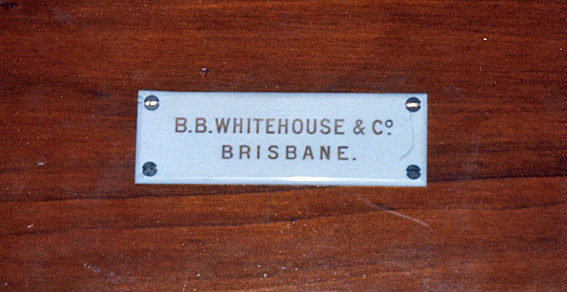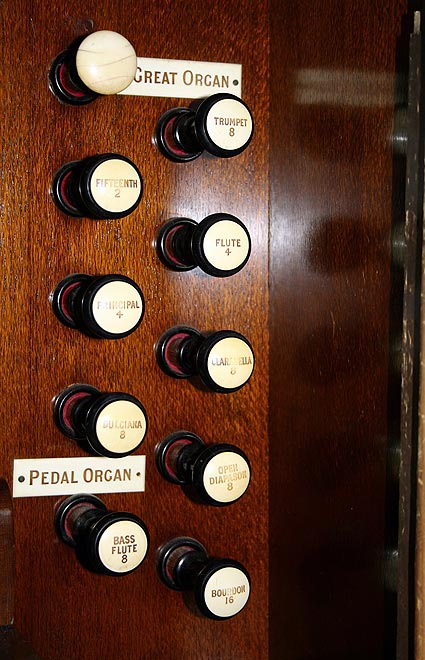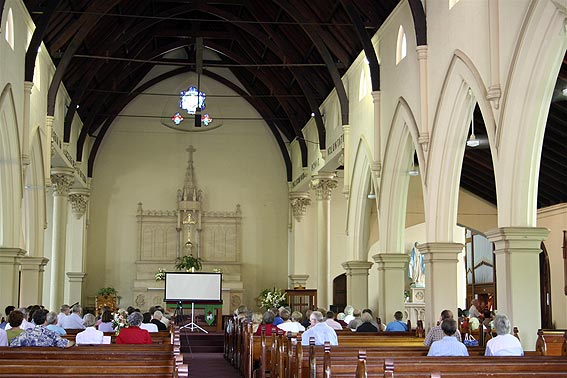
St Mary's Catholic Church, Maryborough
[Photograph by Trevor Bunning (October 2007)]

St Mary's Catholic Church, Maryborough
[Photograph by Trevor Bunning (October 2007)]
Historical and Technical Documentation by Geoffrey Cox
© OHTA 2007, 2012, 2015 (last updated January 2015)
Maryborough developed as a port on the Mary River from 1843 onwards, providing transport for wool from sheep stations further inland. The original township was situated on the north of the Mary River, but it was re-established in the present location further east from the early 1850s onwards. Maryborough flourished particularly after the late 1860s, when gold was discovered in Gympie, for which Maryborough served as the port.
The first Catholic services in the area were held in 1852 in the house of the local chief constable, and a timber church was opened on the present site of St Mary's Church in 1858. The present building was completed in stages: The original section, opened in 1872, was designed by Charles Tiffin of Brisbane. In 1884-85, the nave was extended by three bays and a large chancel was added to the design of F.D.G. Stanley of Brisbane. Finally, in 1936, the length of the nave was again increased, and north and south chancels were added, along with sacristies, confessionals and a baptistry, to the design of the local architect, P.O.E. Hawkins.1

St Mary's Catholic Church, Maryborough, in 1878
[Photograph: John Oxley Library, State Library of Queensland]
The organ was built by B.B. Whitehouse & Co. of Brisbane in 1912. It left the builder's workshops early in August that year, and was described at the time as the "largest organ built in Queensland":
A Magnificent Organ.
The largest organ built in Queensland will leave the workshops of Messrs B. B. Whitehouse and Co. this morning, and will be taken to Maryborough by steamer, where it will be installed in the Maryborough Roman Catholic Church. When installed it will be the largest in any Roman Catholic Church in Queensland. The organ is a magnificent instrument, built of specially selected Queensland pine, with a wax finish, and covers a floor space 12ft. by 11ft., while the highest point is about 16ft above the floor. The pipes and the manuals were imported from England and were put together [with] the woodwork of the organ made by Messrs. Whitehouse & Co., in their George-street workshops, under the personal supervision of Mr. J. H. Whitehouse. The organ possesses two manuals and pedals, 22 stops with three composition pedals to the swell organ and three [composition] pedals to the great organ, and about a thousand pipes. Several prominent organists, among whom were Messrs. S. G. Benson, G. Sampson (city organist), and A. H. Littler, called at Messrs. Whitehouse and Co.'s workshops yesterday, and each, after personally testing the organ, expressed delight at its beautiful mellow tone. The first organ made in Queensland was constructed under the personal supervision of Mr. B. B. Whitehouse, senior member of the firm, 26 years ago, and since then the firm has had continuous experience of this class of work. The organ will be officially opened in the Maryborough Roman Catholic Church at a service conducted by Archbishop Duhig on the first Sunday in September.2

The builder's nameplate on the organ
[Photograph by Geoffrey Cox (October 2007)]
The installation of the organ in Maryborough was carried out under the supervision of Mr J.H. Whitehouse.3 Mr S.G. Benson of Brisbane presided at the instrument for the opening on Sunday 1 September 1912, and gave a recital on the following evening:
The new organ, which has just been installed in St Mary's Roman Catholic Church, was opened on Sunday by Archbishop Duhig. Mr. Benson, of Brisbane, was specially engaged for the services, and his able playing brought out to the best advantage the beautiful tones of the new instrument. Messrs. B. B. Whitehouse and Co., Brisbane, were responsible for the erection of the organ.
Mr. S. G. Benson, of Brisbane, on Monday night gave a most enjoyable recital on the new organ at St Mary's Roman Catholic Church, the building being fairly well filled. The programme, which included "The Storm," was interspersed with vocal items by Miss Nellie Dunne, of Gympie, and Mr. G. McGhie. Archbishop Duhig and Father Brady afterwards addressed the audience. It is understood that Miss Josephine Concannon will be the organist at St. Mary's.4

[Photograph by John Maidment (October 2007)]
The organ was overhauled by Whitehouse Bros in 1936 at a cost of £190.19.4.5 This was at the time when the building was enlarged, and when the organ was moved from the gallery at the west end to the south transept. It was placed unusually against the (liturgical) west wall of the transept, speaking towards the high altar rather than into the nave.

The Whitehouse organ positioned against the wall of the transept, 1936-1990
[Photograph by Howard Baker (c.1989)]
This organ was the largest of all the mechanical-action instruments built by the Whitehouse firm, and it is significant that it has been preserved without major alteration. The other surviving mechanical-action organs of comparable size by the firm were all built earlier: Congregational Church, Wharf Street, Brisbane (1899; 14 stops), Wesley Uniting Church, Kangaroo Point (1903; originally 9 stops) and All Hallows' Convent, Brisbane (1911; originally 8 stops).

The console of the Whitehouse organ
[Photograph by Trevor Bunning (October 2007)]

Tropic-pinned ivories on the keyboards
[Photograph by Geoffrey Cox (October 2007)]
The ivories on the keys are tropic-pinned to guard against the ravages of the tropical climate - a feature that may be observed also on the Whitehouse organ now at All Hallow's Convent, Brisbane, formerly at Holy Trinity Anglican Church, Mackay. As in other organs by Whitehouse of this period and later, the metal pipework derives from A. Palmer & Son of London.
A thorough restoration of the instrument was undertaken in 1990-91 by W.J. Simon Pierce of Brisbane. The organ was turned 90 degrees at this time so as to speak directly into the nave, and the Pedal Bourdon was re-positioned accordingly. Tuning slides were fitted to the pipes. The Trumpet 8ft stop, for which a spare slide had existed on the Great, was added in 1991 to complete the original scheme, scaled on the existing Whitehouse Trumpet (1915) at St Mary's Catholic Church, Ipswich.6 The organ survived an infestation of termites in the church in 2000, necessitating its complete dismantling, cleaning and re-assembly by W.J. Simon Pierce.7


Stop jambs of the Whitehouse organ
[Photographs by Trevor Bunning (October 2007)]
| GREAT Open Diapason Clarabella Dulciana Principal Flute Fifteenth Trumpet SWELL Lieblich Bourdon Open Diapason Stopped Diapason Salicional Voix Celeste Gemshorn Piccolo Cornopean Oboe PEDAL Bourdon Bass Flute COUPLERS Swell to Great Great to Pedals Swell to Pedals |
8 8 8 4 4 2 8 16 8 8 8 8 4 2 8 8 16 8 |
[std metal bass] [gvd bass] [stopped] [1991] [bottom octave unenclosed] A A |
Tremulant
Attached draw-stop console
Pedalboard: radiating & concave
Mechanical action (pneumatic action on pedals)
Compass: 58/30
Hitchdown lever swell
3 composition pedals to Great
3 composition pedals to Swell
Originally handblown.8
This instrument speaks still with complete integrity as a Whitehouse organ. It is the largest mechanical-action instrument completed by the firm, and is of considerable significance in having survived essentially in its original state. The entire tonal scheme, including the Trumpet stop added in 1991, produces an outstanding ensemble.
______________________________________________________________________
1 Queensland Heritage Council, Queensland Heritage Register, location 600692; Denis W. Martin, The Foundation of the Catholic Church in Queensland (Toowoomba: Church Archivists' Society, 1988), pp. 140-41.
2 The Brisbane Courier (9 August 1912), p. 10; Whitehouse Bros List gives 1910, which is presumably the date when the contract was signed.
3 The Brisbane Courier (23 August 1912), p. 4.
4 The Brisbane Courier (6 September 1912), p. 4.
5 Whitehouse Bros Ledger (1922-1940), p. 435.
6 Organ Society of Queensland Newsletter, vol. 16, no. 6 (June 1989), p. 53 & vol. 18, no. 2 (October 1990), p. 36 & back cover / Organ Society of Queensland Newsletter, vol. 18, no. 3 (December 1990), pp. 51-52 & vol. 18, no. 4 (February 1991), p. 35.
7 The Organ Voice, vol. 26, no. 4 (December 2000), pp. 26-27.
8 Specification noted by G. Cox, July 1974 and October 2007.



[Photographs by Trevor Bunning (October 2007)]